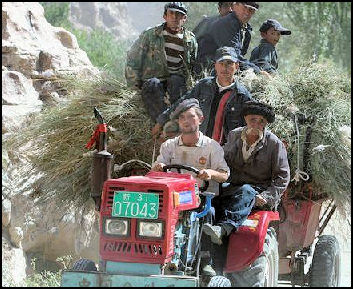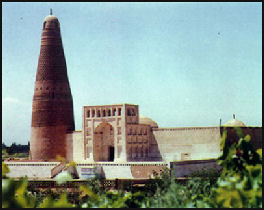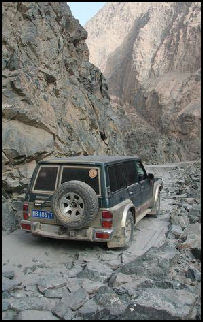LIVING IN THE DESERT

Tajiks on a tractor Some desert people have traditionally lived by raising crops at oases. Others have been nomads. T.E. Lawrence once wrote that desert nomadism was “deeply biting of all social disciplines...a life too hard for all but the strongest and most determined.”
Life in the desert can take its toll. Herdsmen who have spent their lives in the sun often develop cataracts late in life.
People in the desert have traditionally rarely taken baths. With little moisture there is almost no odor.
See Bedouins.
Websites and Resources on Deserts: United States Geological Survey usgs.gov/gip/deserts ; Desert USA (good info on the world’s deserts); desertusa.com/life ; United Nations Global Desert Outlook unep.org/geo/gdoutlook ; Desert Biome article, University of California, Berkeley Desert Biome ; Blue Planet Biomes (about U.S. deserts) blueplanetbiomes.org ; Wikipedia article Wikipedia ;National Geographic online article National Geographic Oxfam Cool Planet oxfam.org.uk/coolplanet ; Sand Dunes article waynesword.palomar.edu ; United States Geological Survey usgs.gov/gip/deserts
Desert Towns and Villages
People have traditionally built villages around oases and other sources of water. Wells are dug and used to provide water for a household and irrigate vegetables, fruits and grains. Palm tree trunks are used in to make house frames, bridges that cross canals and grids and fences.
Desert villages are made from bricks that have the same color as the surrounding sand and rocks. Some towns grew into fortified settlements for protection against raiders.
Oases town that once could only be reached with camels now have airports and are connected to the outside world by paved roads.
Many oases towns are threatened by unchecked population growth and overdevelopment. Their environments are very fragile and their water supplies and resources are limited to begin with an they can’t handle the stress of too many people. Cars and air conditioning pollute the irrigation systems.
The buildings in ghost towns often become havens for scorpions and snakes and nobody wants to sleep in them.
Desert Homes

Turpan mosque in China Buildings have traditionally been made from sun-dried mud bricks. When asked if the mud houses were hot inside, one man told National Geographic, "Never! These old mud-brick houses were the coolest houses you can imagine. Not like the concrete ovens they build now. The high windows are used to trap the desert air and send it down through the streets. That's why people went on living here."
Many desert houses are designed to be cool, and well shaded in the summer. The ceilings are often vaulted to prevent humidity. In the ceiling and roof sometimes are various devices including pipes that aid ventilation and carry breezes and circulate them around the house.
Concrete homes that have replaced traditional mud-brick homes are not as cool as the traditional mud brick homes
Desert Foods
see Desert Crops
Desert Safety

transport troubles
If you are going to the desert make sure have eye protection (glasses or ski goggles), and something to cover you mouth and nose if necessary. It is not a bad idea to bring a surgical mask or painters mask. Desert winds can blow sand and grit into the eyes and mouth.
Heat Protection: Dehydration is a serious problem in the desert. It is possible to die in less than four hours in wrong part of the desert at the wrong time. It goes without saying to bring lots of water, at least 5 liters per person a day, and have access to shade. To avoid heat exhaustion and heat stroke stay in shade as much as possible, get enough salt, replace electrolytes with fruit juices or prepared drinks that replace the salts you lose, stay out of the sun and don't do strenuous exercise after 10:00am and before 4:00pm.
Sun Protection: Make sure you use a sun screen rated "15" or above if you are going to be outside a lot. Sun glasses, protection for your lips, a hat and long sleeve shirt are also a must. If you do physical activity when it is hot it is good idea to go out early, right after sunrise if you can, and take a rest or a nap in the shade in the afternoon, and continue on in the late afternoon.
Health and Drinking Water
A person left alone in the desert with no water or shade can die in less than a day. It is possible to dehydrate and die in the direct sun on the desert in less than five hours. There are stories of people drinking their own urine to survive.
In the middle of the day the desert is so dry and hot that sweat evaporates before it does much cooling and people can easily lose a liter of liquid an hour from their bodies. Travelers in the desert are recommended to take a minimum of 12 pints per person per day. In the middle of a hot desert, a person can sweat about two gallons of water a day, just sitting and doing nothing and four gallons by walking.
Desert people conserve their energy and don't need to drink as much as much Westerners. During rest stops local people often prefers a cigarette over a swig of water and offer what little water they have to strangers as a gesture of hospitality even if it means their own supplies of water tun dangerously low.
Dehydration
 If a person loses a gallon of water and doesn't replace any of it, he experiences dehydration: parchment skin, dizziness, fatigue, loss of appetite, a low fever, and irritability.
If a person loses a gallon of water and doesn't replace any of it, he experiences dehydration: parchment skin, dizziness, fatigue, loss of appetite, a low fever, and irritability.
When the temperature in the desert rises near 120̊F a person's pulse speeds because the body can not dispel the warmth. If a person loses two gallon of water and doesn't replace any of it, he can't stand up; his tongue swells and thickens; swallowing is difficult; moving, even crawling becomes impossible; the outer layers of skin tighten, darken and split. Eventually the liver and kidneys begin to fail. As the body temperature rises, the central nervous system can no longer control the heart rate and breathing. The person slips into a coma and dies.
One resident of the Sahara told National Geographic, "Two years a friend of mine got lost here for nine days. By the time we found him, his face was black. We could not tell who he was. Not until we got some water into him and he regained consciousness a few days later could he speak his name. We were all shocked."
Heat Exhaustion and Heat Stroke
Water acts as a coolant. Your body loses it through perspiration, digestion and urination. If you consume less water than you use you risk overheating and this can have dangerous consequences. The first signs of trouble are often are heat cramps. If the condition get worse it can progress to heat exhaustion and then heat stroke.
Heat cramps are the least dangerous of heat-related conditions. They serve as a warning that more serious things might happen if your body isn’t cooled down with some water or shade. The symptoms include cramps, muscle twitching, and lightheadedness.
Heat exhaustion is a serious condition. It is characterized by severe fatigue, headaches, confusion, nausea, weak pulse, cold clammy skin, and giddiness.
Heat stroke is a very dangerous and potentially fatal condition characterized by a high body temperature and no sweating. People with heat stroke need immediate hospitalization; in the meantime keep them cool with wet towels.
When in a hot place drink lots of water (carry at least 5 liters per person per day), replace lost salt and electrolytes with fruit juices or prepared drinks or rehydration salts (salt and sugar), don't do strenuous exercise after 10:00am and before 4:00pm, and stay in the shade.
Driving in the Desert
 Visitors to the desert are advised to 1) take plenty of fuel and water (at least five liters per person a day), 2) tell people where you are going, 3) let people at your destination know your approximate arrival times, and 4) stay near marked roads. 5) Make sure you a radio or cell phone to call for help. 6) If you break down stay with your car. Don't try to walk out. 7) Also be prepared for sandstorms and flies. The flies are particularly nasty if there has been some rain.
Before you set out make arrangements with the Desert Police Patrol. Know the locations of their outpost in the desert.
Visitors to the desert are advised to 1) take plenty of fuel and water (at least five liters per person a day), 2) tell people where you are going, 3) let people at your destination know your approximate arrival times, and 4) stay near marked roads. 5) Make sure you a radio or cell phone to call for help. 6) If you break down stay with your car. Don't try to walk out. 7) Also be prepared for sandstorms and flies. The flies are particularly nasty if there has been some rain.
Before you set out make arrangements with the Desert Police Patrol. Know the locations of their outpost in the desert.
Make sure your vehicle has four wheel drive and tires designed for desert. Bring along shovels and perforated steel or aluminum mats, to help you get out of the sand if you get stuck. When driving in the sand, deflate your tires for better traction. If you are heading to some really remote place it is a good idea to travel with at least two vehicles in case one vehicle has problems.
Mechanical problems — shredded fan belts, broken fan blades, torn radiator hoses, leaky radiators, sand-clogged carburetors and fuel lines and electrical system failures — are often related to invasions of sand and blistering heat and stress on the cooling system.. If nothing else is available a radiator can be patched with a mixture of barely flour and camel dung.
Plastic containers should be used for water, and steel jerry cans for gasoline. Try to avoid putting gasoline in plastic containers. You may want to bring snake anti-venom and scorpion anti-venom for the snakes and scorpions you might encounter. These sometimes need to refrigerated.
It is advisable to get a guide and maps with track notes if they are available. Avoid traveling in the summer when temperatures are very high and dust is problem. In the winter rainy season tracks can be washed out or closed by floods. Spring and summer sandstorms can clog carburetors and cause vehicles to break down, and reduce visibility to near zero, making it easy to get lost. Companies that rent vehicles for desert driving often require huge deposit and insist one of their people to goes along.
Driving in the Sand
Tracks and roads are hard to establish in sand dune areas because they can be quickly covered by wind-blown sand. Drivers deflate their tires on the soft sand and sometimes inflate and deflate their tires with the changing conditions of the sand and heat. The mid day heat is sometimes so intense that the sand becomes impassibly soft.
In sand dunes it is good idea to drive fairly fast to avoid bogging down in the sand. Describing a journey through the sand seas of the central Sahara, Donavan Webster wrote in National Geographic, "Most every day we drive about 70 miles across the soft sand, often becoming bogged down and having to dig our way out with hands and shovels, placing perforated metal sheets called 'sand ladders' beneath the tires for better purchase."
Swerving from side to side helps you get traction and momentum. If you get stuck use the low gears to ease you self out. If you get really stuck bring out the mats and shovels. Place the mats in front of the drive-train wheels and get people to push as you slowly accelerate out. If you don’t have any matts use some branches from a bush or tree. If you in a place with no bushes or trees make sure you get some branches before you set out.
If you get really, really stuck release the wheels by using a jack to lift up the car. To do this: 1) put the jack on a flat, heavy object; 2) lift up the car; 3) free the wheels; 4) bank up the right side of the wheels; 5) place the matts or branches over the hole; 6) put the wheels on the mats or branches; and 7), free the car and drive at an average speed. Never release the tires with your hands as you risk plunging the car deeper into the sand. If that doesn’t work you need another vehicle and winch to pull you out.
Desert Driving Safety
Many people die after getting lost or after their vehicle breaks down. In April and May 2001, 93 illegal African immigrants died found in the Sahara Desert in Libya. They had entered Libya from Niger by truck but became marooned when the truck carrying them went off the main track to avoid the border post at the Libyan border and broke down. Most of the victims were from Niger. Others were from Chad, Sudan and Nigeria. The truck driver and 25 others survived.
Visitors to the desert are told to take plenty of water, tell people where they are going, tell people at your destination of your approximate time of arrival, and stay near marked roads. Many roads are subject to flooding. They should keep in mind that the roads are dirt or gravel and often in poor condition, The distance s between towns can be hundreds of miles and service stations are few and fare between. You also need to watch out for kangaroos, camels and other animals,
At least two vehicles ride together. If one breaks down or gets stuck, the other can help. Get a vehicle that has a two-way radio so you can call for help if you get in trouble. A minimum of 20 liters of water should be carried in different containers. State automobile association provide useful maps and track notes. Avoid traveling in the middle of the summer when temperatures are very high and dust is problem. Travelers wait out the midday sun by tying large canvas sheets from vehicles and creating shade. Also avoid the rainy season when tracks can be washed out or closed by floods.
An average scientific expedition into the deep desert requires six of seven jeeps, a tanker each for water and fuel and a 12-ton truck for food and supplies. It is also important to bring along a good mechanic and winch to pull you out of deep sand. Sometimes the maps of a particular region are based on accounts by explorers from the 1930 that describe the vast region in terms of "big hills," "soft ground," "open sand plain," and "bad going." On some routes if you travel for a distance and don't see any bones, you are worry, because then you may be lost."
Image Sources: mongabay.com
Text Sources: "Deserts Geology and Resources" by A.S. Walkers, USGS Online publication; Rick Gore, National Geographic, November 1979 [┵]; New York Times, Washington Post, Los Angeles Times, Daily Yomiuri, Times of London, National Geographic, The New Yorker, Time, Newsweek, Reuters, AP, Lonely Planet Guides, Compton’s Encyclopedia and various books and other publications.
Last updated March 2011
